Levee breaches, even in Mississippi River levees, potentially could be closed in a matter of hours using only fabric tubes and something abundantly available in a flood: water.
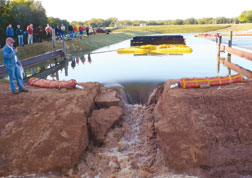 Angelle Bergeron /ENR
|
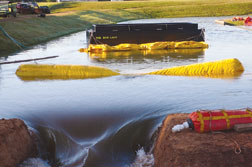 Angelle Bergeron /ENR
|
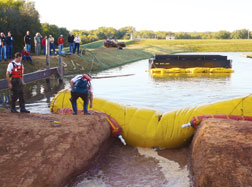 Angelle Bergeron /ENR First plug test sealed the breach in 12 seconds. A second test awaits offshore.
|
The results of a Sept. 30 demonstration at 1:4 scale of three new rapid levee-breach-repair techniques developed by the U.S. Army Corps of Engineers Engineer Research and Development Center in Vicksburg, Miss., are “really impressive,” says Wil Laska, program manager for the Dept. of Homeland Security’s Levee Strengthening Program. DHS funded the proof-of-concept research and testing through its Advanced Research Projects Agency.
DHS hopes to partner with California’s Dept. of Water Resources to further test the concepts. “We want to interface with the folks in California because they have a lot of levee problems,” Laska says.
The Corps conducted the demonstration at the U.S. Dept. of Agriculture’s Agriculture Research Service’s Hydraulic Engineering Research Unit Laboratory in Stillwater, Okla. It chose the 100-acre site because it offers an existing, outdoor laboratory and access to a healthy flow of water, siphoned from the adjacent 3,000-acre Lake Carl Blackwell Dam.
ERDC proved three rapid-repair methods at the demonstration. Donald Resio, ERDC’s senior scientist, says they all rely on a fundamental property of water—incompressibility. All three techniques use water to fill a fabric tube that resists deformation past a threshold, Resio says.
ERDC has developed prototypes of lightweight, fabric tubes that could easily be airlifted, positioned and filled in two to four hours. Once launched they could block major breaches in a matter of minutes. “These concepts work and provide a solution if you act quickly,” Resio says.
|
The rapid-repair concepts are not “a magical answer,” but they offer a tool for the problem of closing running breaches that up to now have been considered “intractable” by many engineers, Resio says. The water that flowed for days into New Orleans while helicopters bombed breaches with thousands of sandbags during 2005’s Hurricane Katrina led to an estimated $1.5 billion of additional flood damage.
To be effective, the tubes would have to be pre-positioned near vulnerable areas and crews trained in advance to use them, but they quickly could be helicoptered into sites with restricted access and no logistics support, Resio says.
One demonstration used a test levee the USDA lab constructed with a section built primarily of sand so the Corps scientists could show how rapidly a small opening in an inferior levee can unravel into a major breach. Two men helped the breach start by shoveling a tiny trench in the top of the levee as a 125-cu-ft-per-second flow was pumped into the test pool. A trickle of water started running through the damaged area. “If you had a sandbag, you could seal it at this point, but you would have to be there,” Resio said. In under 14 minutes the trickle had grown into a roaring, 8-ft gap.
“This demonstrates the sort of failure that occurred in Lincoln County, Mo., a few months ago,” Resio said. “Even at 1:4 scale, this is a difficult problem.” A steel plug for such a hole would probably require about 5,000 lb of steel, Resio says.
Instead, ERDC designed a 491-cu-ft, 5-ft-dia., 24-ft-long fabric tube that empty weighs about 200 lb. It can fill through an intake port with 3,672 gallons of water in about 10 minutes using the natural flow at the flood rate of the demonstration. When tethers holding it parallel to the breach were released, the water draining through the gap rolled the tube longitudinally across it, sealing it in about 12 seconds. “That rolling is one of the things that make this system work,” Resio says. The rolling causes the tube to decelerate as it closes in on the hole. “If the tube slammed into the levee, it would take out more levee” Resio adds.
 |
| LASKA |
At full scale, plugging a 32-ft- long breach would take about 30 seconds, Resio says. “We shut down about 99% of the flow,” he says. Smaller diameter trim tubes were available to plug remaining minor leaks. “Someone could get in behind there and actually seal the breach. That tube will not budge. It is as compressed as it can get.” The geometry and compression of the tube creates the seal. It does not rely on support from the adjacent levee, Resio adds.
Another test also demonstrated placing a rolling, decelerating tube of the same dimensions, but this one was guided into place with tethers from a barge. It also sealed the 8-ft. wide breach in a matter of seconds, even though it was not centered exactly. “I am confident that we could use this method for a breach that is 50 ft. wide and 20 ft. deep, which is a Mississippi River breach,” Resio says.
Spillway Aid
The Corps also demonstrated how similar concepts can be used to rapidly create a spillway and protect a levee during permitted overtopping. It involved placing a tube aligned with the streamflow, adjacent to the upstream side of an earthen levee.
The method used lightweight ballast to keep the tube in place as it filled with water. It served as the wet-side anchor for a skirt of protective fabric that was drawn up and over the levee after which an 8-in.-deep flow was allowed to sweep over the top of the levee.
“With this tube in place, we can get about 6 in. more of overtopping [before it is damaged], which means, on full scale, a 2- to 3-ft. flow over a levee for a prolonged time, like what occurred at the 17th Street outfall canal during Hurricane Katrina,” Resio says.
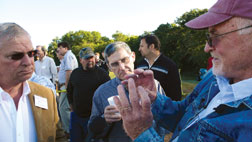 Angelle Bergeron /ENR Resio, right, explains concepts to engineers and levee board officials.
|
To elevate the test levee 6 in. with sandbags would require about 384,000 lb of sand, Resio said. “Sandbags could be used in scale, but would not be successful in full scale, as was demonstrated at the 17th Street canal,” he says.
The next step for the researchers is to increase the test scale to 1:2, says John Verrico, spokesman for the Science and Technology division of DHS. However, finding a place where such a test could be performed is a problem. USDA’s Stillwater facility is the only outdoor laboratory that can accommodate the 1:4 scale test. “This is as big as we can get, short of actually breaching a real levee somewhere, and people discourage that,” Resio says.
Future tests await funding, which is not in place for 2009 but is anticipated for 2010, Laska says. The current project has been in development for 13 months, funded by the DHS with $400,000 in 2007 and $1.2 million in 2008.
The other two components of the DHS’s Levee Strengthening Program—remote sensoring of levees and strengthening methods—are “in a holding pattern, awaiting funding,” Laska says.


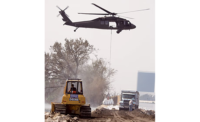
Post a comment to this article
Report Abusive Comment